We have a strict honesty policy, but please note that when you buy through our links, we may earn a commission. Learn more.
In this Printful review, I’m going to walk you through the platform’s key features, including its product range, shipping options, integrations, branding options and much more. Is it right for you, or should you try another platform?
Let’s kick the full review off with a key question. What is Printful?
What is Printful?
Printful is a print-on-demand (POD) service that lets you design, print and sell custom merchandise through your own online store or via an ecommerce marketplace like Amazon, eBay or Etsy.
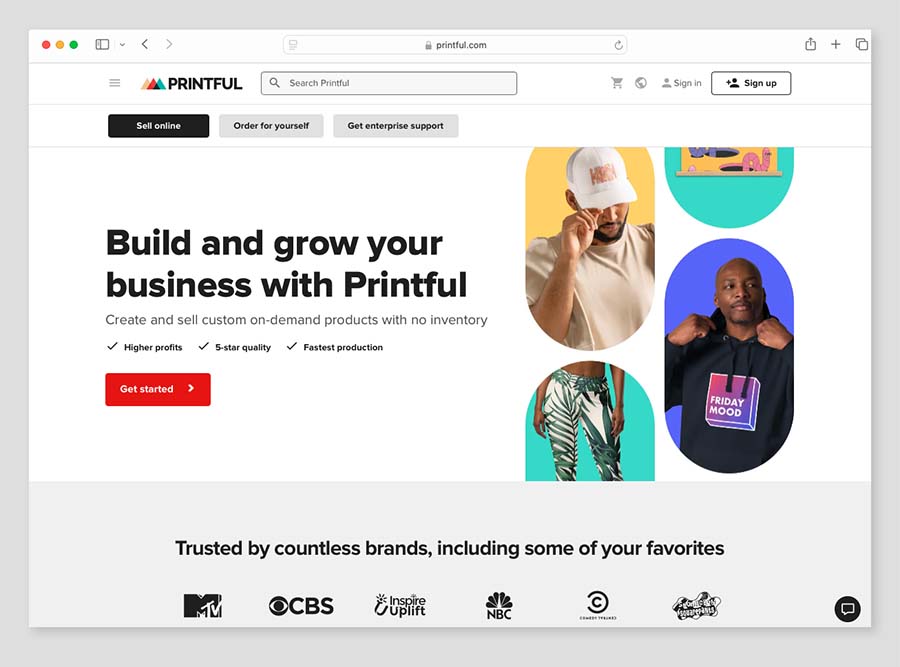
It provides you with a wide range of printable products that you can add your own brand or designs to — and doing this is very straightforward thanks to Printful’s product template builder, which includes an easy-to-use design tool.
But Printful doesn’t just print your products for you!
It also provides a complete range of ‘fulfillment services’ — in other words, the company also packages your products and ships them to your customer for you.
The key benefits of a print-on-demand fulfillment service like Printful for ecommerce merchants are twofold:
- You don’t need to pay any upfront inventory costs.
With Printful, you don’t need to pre-order any products and there are no order minimum quantities. This means you don’t have to invest in warehousing or storage for products that may or may not sell when you list them on your store. Furthermore, the company only charges you when a customer completes an order on your store — so technically, the full cost of printing and delivering a product to a customer can be covered by the customer’s payment for that product at time of purchase. - You can avoid time-consuming fulfillment tasks on product orders.
Because Printful takes care of printing, packing and delivering your items to your customer for you, you save a huge amount of time that can be devoted to other key tasks like developing your brand and promoting your store.
With the rise of Printful and similar services, it has never been easier to start a print-on-demand business. In fact, the global print-on-demand market is projected to be worth $39.87 billion by 2030, which explains why more and more online merchants are looking to get into this potentially lucrative selling space.
So let’s take a quick look next at how many people use Printful…
How many people use Printful?
According to the company, Printful currently has over one million registered users, making it one of the biggest print-on-demand services on the market today.
Over a quarter of a million Printful users operate their own storefronts on ecommerce platforms such as Shopify, Wix and WooCommerce. Of these, Shopify is by far the most popular tool used in conjunction with Printful, with over 122,000 Printful app installations being made on Shopify (compared to 69,000 on Wix and 0,000+ on WooCommerce).
Printful was founded by Latvian businessmen Lauris Liberts and Davis Siksnans in 2013; the company hit the significant milestone of 5 million printed products five years later in 2018. Since then, Printful’s processing numbers have grown exponentially — the company has now processed 98 million items in total, with a current average of 1 million items being processed each and every month.

Printful is a privately-owned company, and — thanks to a $130 million investment by private equity investor Bregal Sagemount in 2019, it is is the first privately-owned enterprise with Latvian roots to be valued at over $1 billion US dollars.
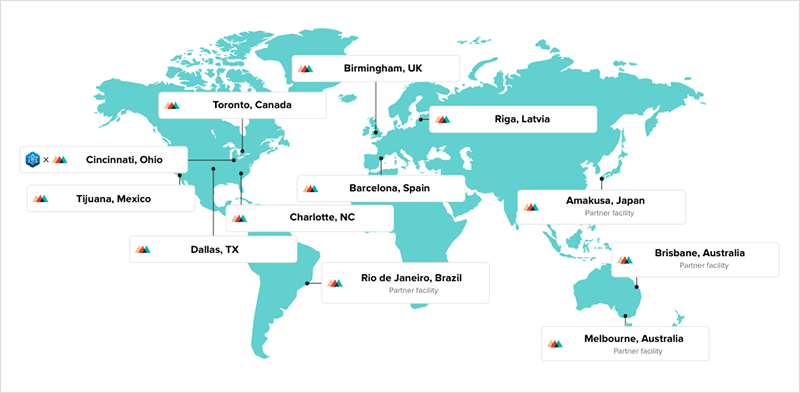
A key USP of Printful is the fact that unlike most competing print-on-demand services, a large proportion of Printful orders are printed in-house (i.e., in a Printful-owned production facility) rather than being outsourced for printing to third-party printers.
But how exactly does Printful work?
How Printful works
To create a viable print-on demand business you need three things: products, a sales channel (online store or marketplace) and a fulfillment service.
Printful gives you all three of these in the form of:
- product creation tools
- integrations with ecommerce platforms and marketplaces
- packing, shipping and delivery services.
Let’s take a quick look at each of these.
Product design
Printful gives you a choice of 371 customizable print items to choose from. Each of these can be customized via Printful’s drag-and-drop ‘product designer’ (more on which later).
Importantly, every Printful product comes with detailed product descriptions and mockup images that can be imported easily into your chosen sales channel (meaning that you don’t have to worry about product photography or copywriting).

Sales channels
You can sell Printful products on 23 different sales channels, including well-known online store builders like Shopify, Squarespace and Wix, and online marketplaces like Amazon, eBay, Walmart and Etsy.
You connect Printful to these via ‘integrations’ — these are available on the Printful website and extremely easy to implement.

When you connect your Printful account to a sales channel using one of these integrations, a two-way flow of information between Printful and your ecommerce platform / online marketplace is created.
You can easily add Printful products to your store, and Printful automatically receives order data (and payment) when a customer buys one of these products.
Fulfillment
When a sale occurs on your store, Printful…
- deducts its fee from your sale price
- prints the item
- packages it up
- ships it to your customer.
I’ll dive into the nitty-gritty of all of the above as we go through this review, but first, let’s take a quick look at the kinds of things you can sell with Printful.
Printful’s product range
Printful’s product catalog currently features around 370 products. This range is larger than those offered by competitors like Spring, Spreadshirt or SPOD (which let you sell / print 125+, 175+ and 200+ products respectively).
You can check out Printful’s full product range here.
However, some companies offer significantly larger product catalogs than Printful. A notable example here is key competitor Printify, which gives you a choice of 1,000+ products to sell on your store — twice Printful’s offering.
(You can check out our Printful vs Printify comparison here or read our Printify review here).
That said, it’s worth bearing in mind that Printful prints its full range of products in its own printing facilities rather than outsourcing this work to third-party printers (like Printify does). This gives Printful full control over the production process of your goods.
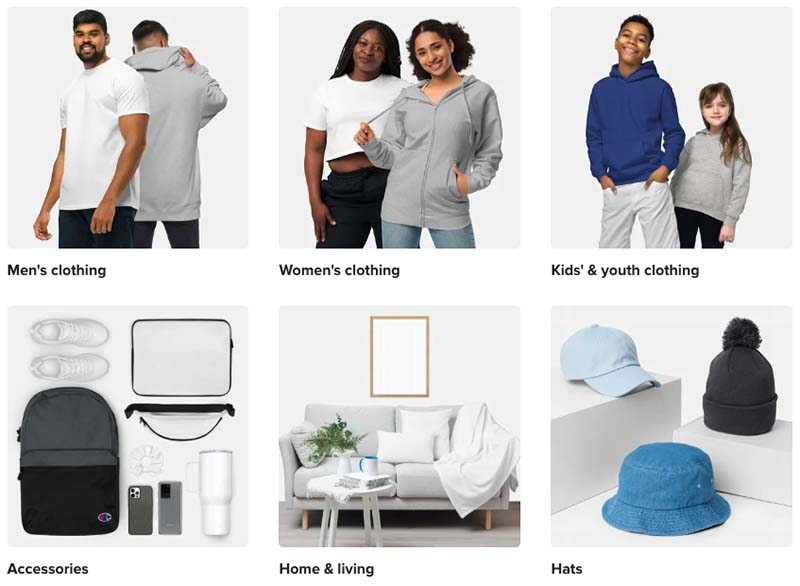
Printful’s product range covers 6 main areas of printable goods.
These are:
- Men’s clothing — including shirts, t-shirts, jackets, hoodies, sweatshirts, pants, swimwear and underwear.
- Women’s clothing — including tank tops, crop tops, t-shirts, dresses, sports bras, skirts, robes, swimwear and leggings.
- Kids’ & youth clothing — including hoodies, jackets, baby bibs, baby bodysuits, shirts and swimwear.
- Hats — including beanies, baseball caps, snapbacks, trucker hats, bucket hats and visors.
- Accessories — including tote bags, fanny packs, handbags, flip flops, shoes, socks, phone cases, laptop cases, mouse pads and face masks.
- Home and Living — including posters, canvas prints, blankets, candles, water bottles, mugs, notebooks, greeting cards, aprons, towels, pet products and beauty products.
Now, Printful’s product library, which you use to find a product to customize, is extremely good.
When you search this library, you’ll quickly see the range of available colors for products, along with sizes, estimated delivery times, and most importantly, the price of each item.
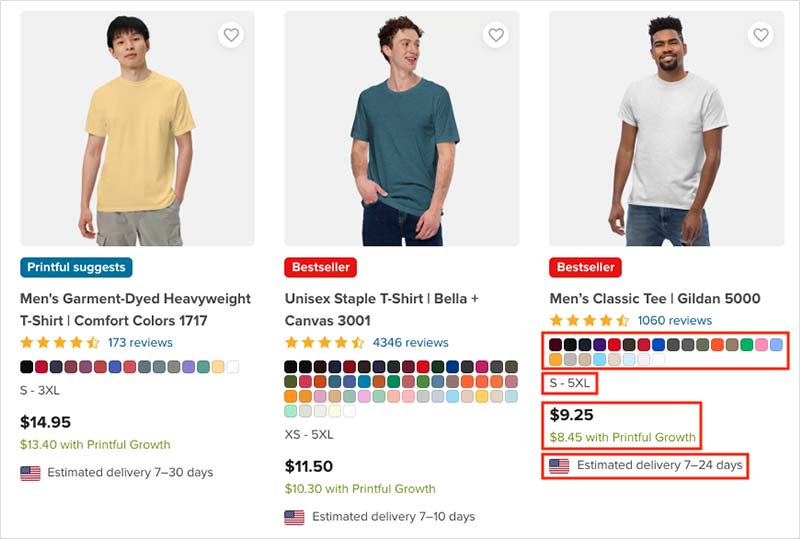
You can also search for products based on the manufacturer of the item. And on this front, it’s worth noting that Printful sources its clothing products from around 30 different brands, including some very well-known ones, like Adidas, Champion, Columbia and Under Armour.
Being able to name-drop a household brand name into a product description on your online store can be a real plus, because it gives you a general selling point along with the opportunity to charge a relatively high premium for a product (people expect to pay more for an item from a brand they recognize and respect).
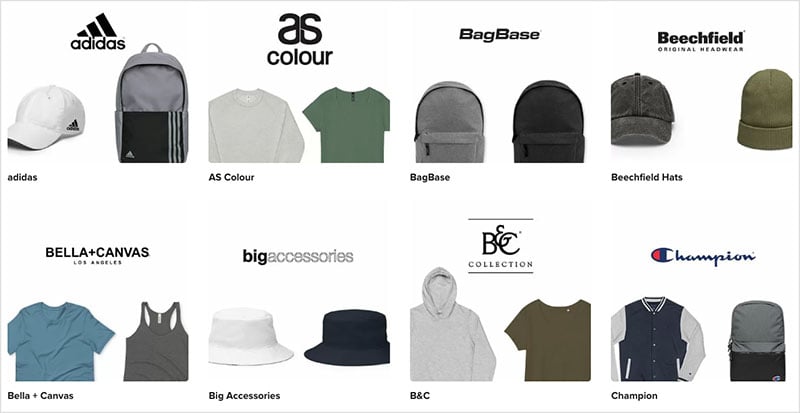
Significantly, when you’re browsing products to add to your store on Printful, you can view reviews of these products from people who have ordered an item. These reviews include user feedback and also feature a rating chart that covers key areas such as ‘product quality,’ ‘fit,’ ‘print quality’ and ‘recommend to others.’
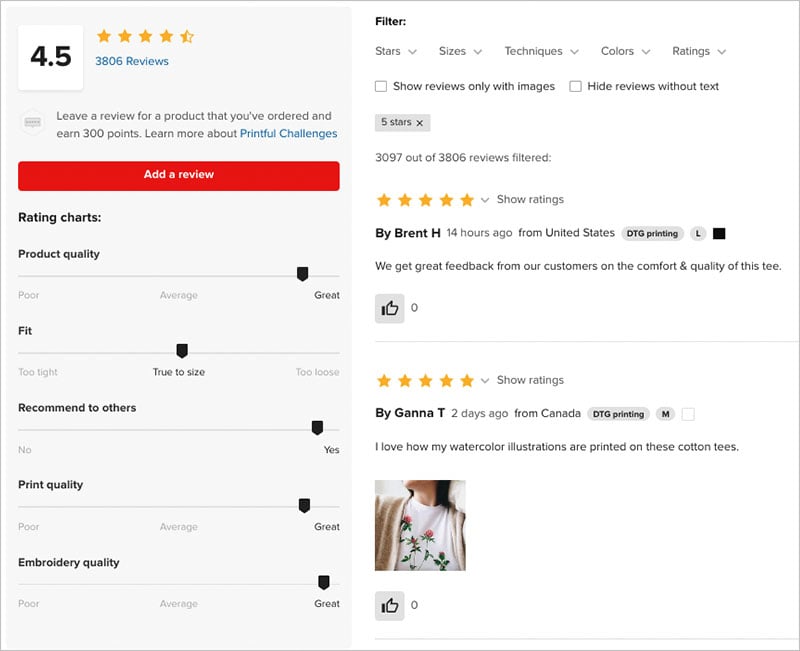
Very few of Printful’s POD competitors take such a transparent approach to community reviews of their products, so a thumbs up to Printful for this.
Print quality
Printful has a reputation for being the POD company with the consistently best print quality — and it’s fair to say this reputation is deserved.
The company has invested over $83 million in its own printing equipment over the last 10 years, which has resulted in it being able to tightly control the print quality of each and every item.
Whether you read feedback from Printful customers on its own website or on those of its integrations partners, print quality is frequently mentioned as a key differentiator between Printful and most competing POD services (who tend to outsource their print processes to third-party printers).
These example below, from some Shopify user, are fairly typical ones.
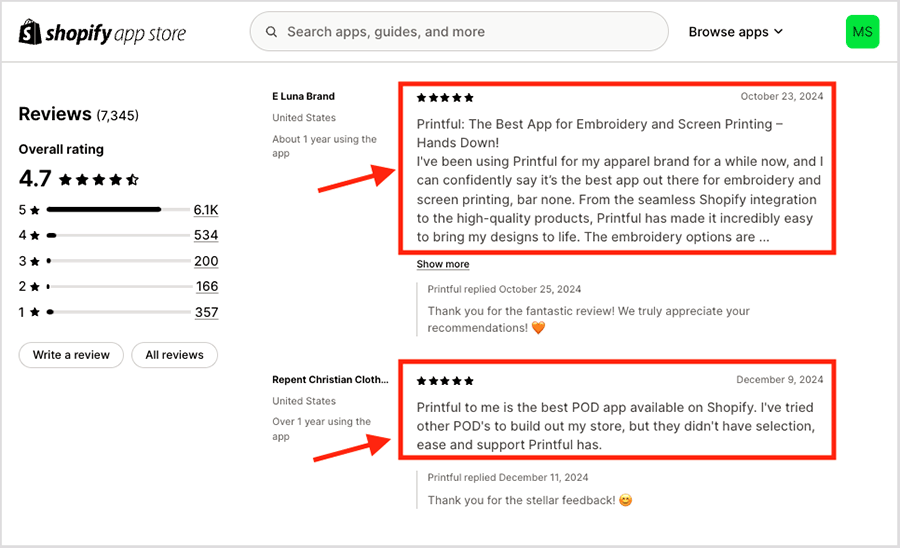
Depending on the product you want to list on your store, Printful give you a range of printing options for it.
These include:
- Direct-to-garment (DTG) printing — this printing method sprays ink directly onto the product and can be used to add detailed multi-color and photographic elements to your clothing and other fabric products.
- Direct-to-film (DTF) printing — Direct-to-Film (DTF) printing enables customization on fabrics unsuitable for Direct-to-Garment (DTG) methods, like fleece and nylon. It’s perfect for complex designs, allowing for sharp, detailed results on intricate graphics, photos, fine art, and small text. This technique excels in versatility and detail accuracy for various textile applications.
- All-over printing — this method uses a heat press to transfer designs to a fabric before the product is cut to size and sewn into the final product.
- Sublimation — similar to all-over printing, sublimation involves embedding your design into the material of a product rather than printing on top of it. This is frequently used for hard-surfaced items like mugs and water bottles, as well as some textile products.
- UV Printing — often used for printing phone cases, UV printing involves using UV light to cure ink graphics, which results in the formation of a hard coating finish.
- Cut & Sew — often combined with some of the other printing methods, this involves cutting and sewing a garment to its completed form after another printing method has been used to apply the design to the material.
- Embroidery — there are two options for embroidery, ‘flat’ and ‘3D puff’. Flat embroidery gives the embroidered piece a flat finish so that it is more or less level with the garment, and ‘3D puff’ embroidery gives a raised look to a piece by adding a foam insert between the embroidery and the main fabric.
Of all the print-on-demand services we researched when preparing this post, customer reviews of the print quality of Printful products were the most positive of the lot.
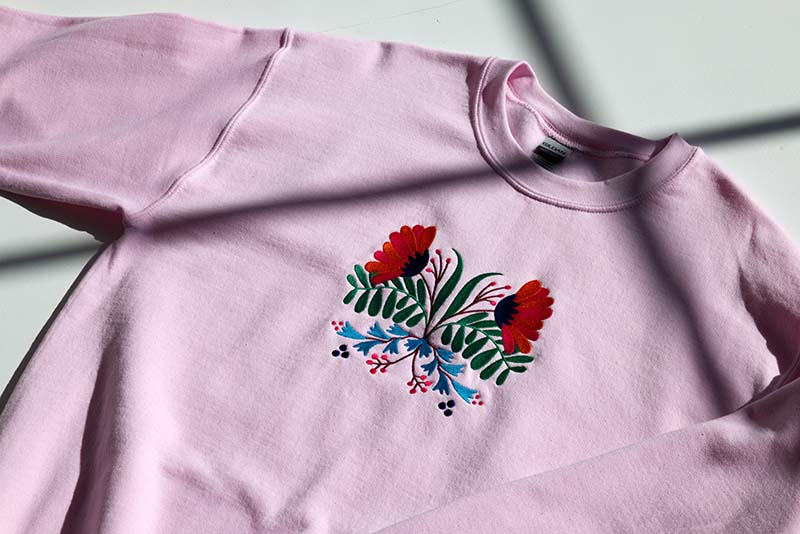
Now, Printful products undergo a 3-step quality assurance process before they are shipped to your customers.
First, the quality of the graphics you’ve applied to a Printful product are checked using automated software. After this, Printful’s in-house team check the quality of the raw products and the print process as the products are being printed. And lastly, the company runs a final quality check once your product has been fully customized.
All of this results in Printful having a return rate of orders due to quality concerns at less than 0.19% of all purchases.
Now, like most POD companies, Printful only offers refunds and replacements for damaged or mislabeled products. If you discover a problem with an order, you can report it and provide photos of the issue on the order summary page in your Printful account.
However, the company does not provide refunds if you or your customer supplied it using the wrong delivery address, or in cases where your customer is suffering from a dose of buyer’s remorse.
Another reassuring aspect of Printful from a from a product quality point of view is the fact that the company is willing to remove products from sale if it finds any problems with material or print quality during its production process.
In fact, while researching this review, I received an email from Printful to notify me that some of its drinkware items were temporarily being removed from sale due to a print quality issue (see screenshot below).
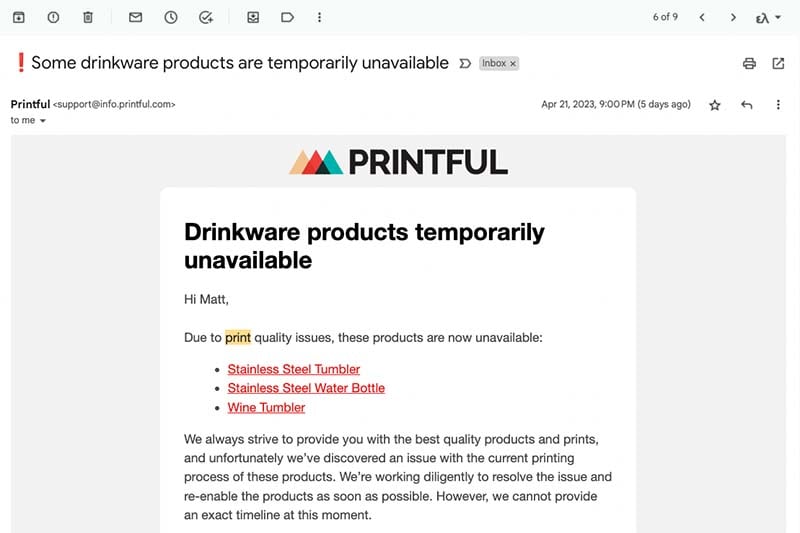
While it might be a bit annoying if a product you were hoping to sell becomes unavailable, I think that this approach shows Printful has a genuine commitment to quality and is willing to forego a few sales to maintain their reputation and quality standards.
Generally speaking, the most common complaint among customers of print-on-demand companies is that the color of printed clothing products tend to fade after the item has been washed a few times; and it is fair to say this issue crops up much less among Printful customers. This is again perhaps due to the fact that Printful is able to manage print quality through its own in-house machines.
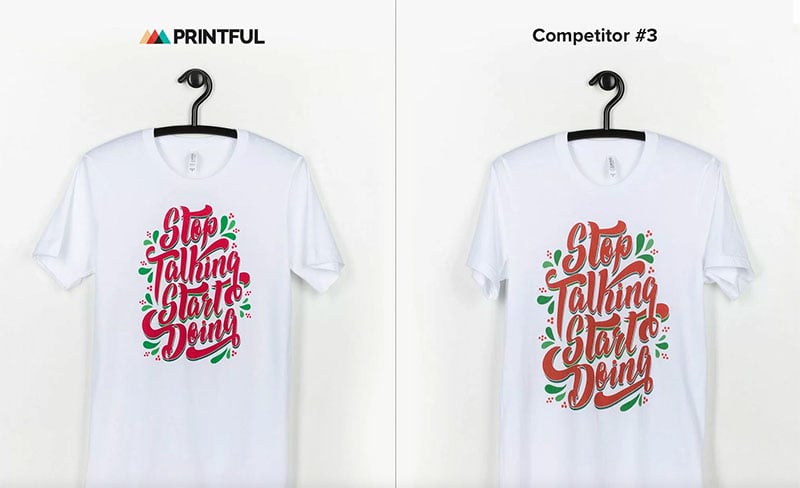
Printful uses top-of-the-range ‘Kornit’ printing machines for its ‘Direct-To-Garment’ print items, which you can learn more about in the video below.
How ethical is Printful?
As a general rule, the processes involved in print-on-demand printing involve much less waste than the bulk ordering processes of traditional printing methods such as screen printing. This is because POD products are only printed once they are ordered — rather than, as is the case with traditional printing, being printed in bulk.
That said, if you’re searching for a POD supplier for your products, it’s still important to assess its environmental and ethical credentials.
Printful scores highly with regard to its approach to sustainable printing and ethical business practices.
In 2023, the company recycled over 463 tonnes of unused products, with an additional 15.2K square feet of fabric and scraps from its production processes being saved and repurposed.
Additionally, Printful’s regional fulfillment centers across 4 continents allow it to fulfil 86% of its orders in the same region as that of the end customer. This results in less fossil fuel usage.
(In terms of raw print materials, Printful’s DTG machines use non-toxic water-based vegan inks with little to no wastewater involved in the printing process).
Printful’s product library includes a special filter for ‘eco-friendly’ products. Clothing products in this category are all at least 70% organic (or use recycled material), and beauty products all carry an ‘Ecocert COSMOS’ certificate as proof of the products ‘natural’ or ‘organic’ status.
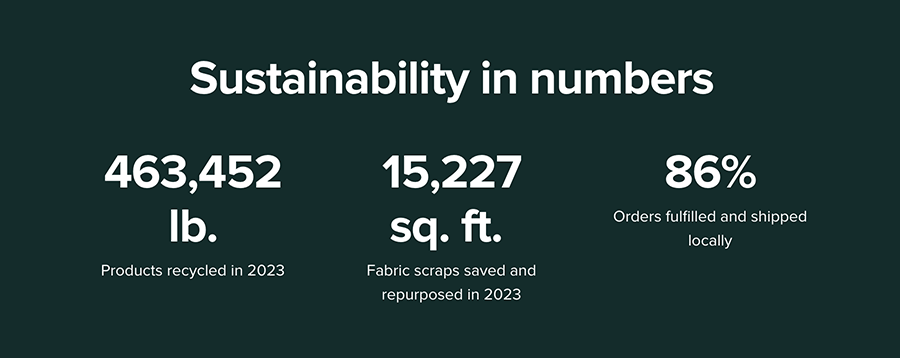
Furthermore, the platform now offers a CO₂ offsetting feature, allowing customers to neutralize the carbon footprint of their shipments. Operated in partnership with Native, a company specializing in sustainability initiatives, this program lets merchants offer an optional shipping rate that funds global emission-reduction projects, further supporting Printful’s environmental efforts.
The company also has a publicly available code of conduct covering human rights, workers’ rights, anti-corruption policies and environmental standards for all third-party Printful suppliers; and it has a statement on its website regarding its compliance with the UK’s Modern Slavery Act.
According to Printful, the company conducts regular audits and inspections of its suppliers’ facilities to ensure that they meet its high standards for both quality and ethical production.
Ultimately, it’s hard to be 100% sure of a company’s credentials when it comes to ethics. But Printful is considerably more open about its approach to the problematic labor issues that often surround dropshipping than other companies, and as far as we can tell genuinely seems to be trying to operate in a way that respects workers’ rights.
Designing products
Print-on-demand companies like Printful do a lot of things for you: they provide you with products, print your designs on your chosen items, and pack and ship these products to your customers for you.
However, there is one part of the print-on-demand process that you have to take care of yourself: designing your products.
To help you with this, Printful provides you with an easy-to-use product design editor. This tool comes with a drag-and-drop interface that lets you upload your designs, position them on your chosen product, add text using over 700 available fonts and make various other customizations.
A bit frustratingly however, there’s no way to upload custom fonts to Printful — meaning that if you want to add text to your design using a typeface that’s not bundled with the tool, you’ll have to save your text as an image in an external graphic design tool first (you could then upload this image to your Printful design). This isn’t ideal.
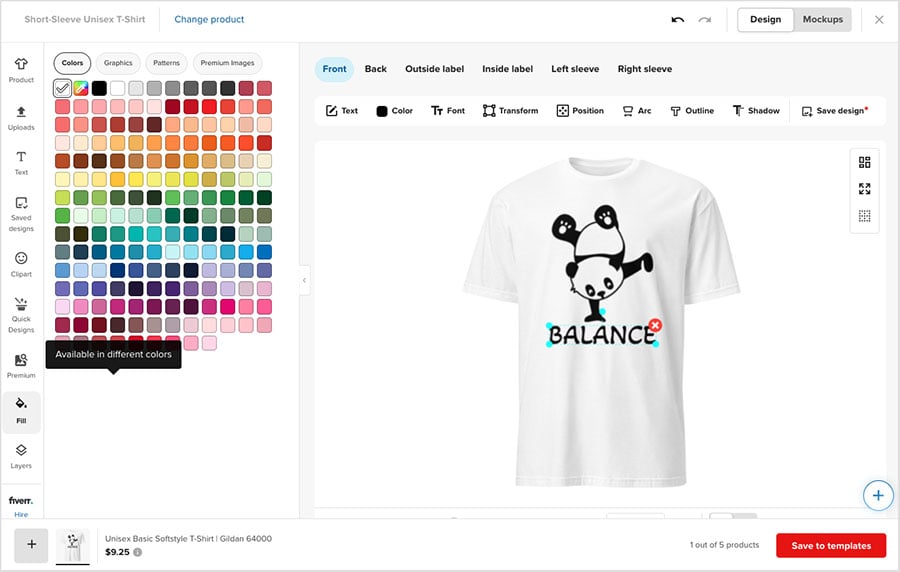
The product designer features a nice set of ready-made icons and patterns that can be quickly added to your designs by using its ‘add clipart’ or ‘add quick design’ options.
If you want to add a photo to your design, you can choose one from a huge range of 80+ million premium Getty images (these cost $1 per placement), or alternatively, add one of your own photos. You can upload JPG or PNG images up to 200MB in size (if you’re creating an embroidered product, you can also upload PDF files).
If you’d prefer to create your own design externally using an app like Canva, Photoshop or Illustrator, Printful helps you here by supplying you with downloadable print file templates (in PNG and PSD formats) and detailed file size guidelines.
These templates make it really easy to work on your design in external graphic design software before uploading it to the product designer in Printful.
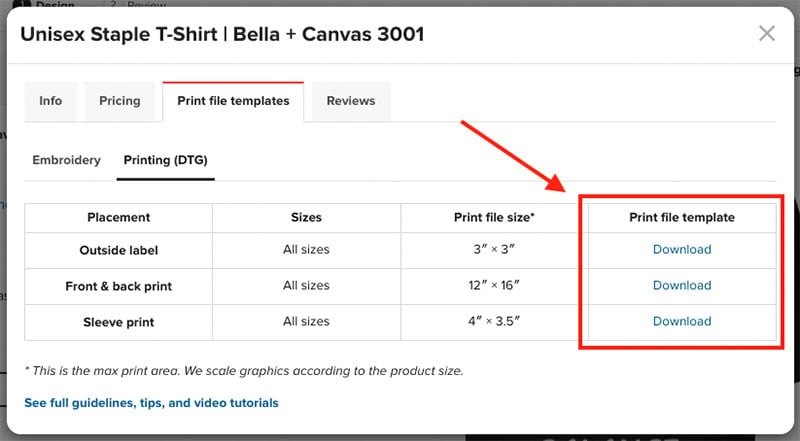
Once you’re happy with your product design, Printful lets you generate product mockups that you can use to showcase items to customers.
You can choose from a large range of ready-made mockups that position your products in a range of real-world situations, or alternatively, you can use Printful’s mockup generator to build your own.
There’s a very large range of 2,550+ mockups available, including nature scenes, flat-lay table tops, home and office scenes as well abstract backgrounds, shapes and patterns.
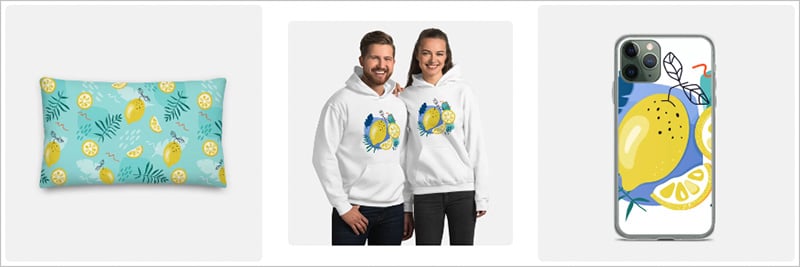
The other key things you can do in Printful’s product editor are customize your product descriptions and set your pricing details.
Every Printful product includes a pre-written product description (in a choice of 11 languages) that covers product material, dimensions, and sourcing information.
Now, while Printful’s default descriptions are well written and represent a good starting point for product copy, it’s important to note that these descriptions relate to the ‘raw’ product only (i.e., before it has been customized with your design). Accordingly, it’s important to edit the product descriptions and make them your own.
Printful lets you set your product prices before adding your customized product to your store. You can apply a percentage-based markup to all of your product variants by using a ‘set revenue’ option, or alternatively apply individual bespoke pricing for each size option of a product.
It’s worth noting that Printful generally recommends a 30% markup on the price you will pay to Printful for any one product.
Offering product personalization to your Printful customers
A feature you get from Printful that’s not available in key competing print-on-demand suppliers Custom Cat, Printify or Spring is the option to let your customers personalize your products, by adding their own text or images to them at point of purchase.
This product personalization option can be used with Printful’s embroidery, DTG and wall art products; and it is currently available for merchants using the Shopify, Etsy and WooCommerce integrations.
This functionality matters because product personalization is an increasingly popular ecommerce trend. For example, on Etsy’s craft market with over 90 million buyers, the term “personalized product” is consistently the most popular search query, with one quarter of all Etsy buyers saying they intend to buy a personalized item on the marketplace.
With the ecommerce personalized gift market set to get bigger and bigger over the next few years, the fact that Printful offers end-customer product personalization is one of the key reasons to consider using it as your POD supplier instead of a competing service.
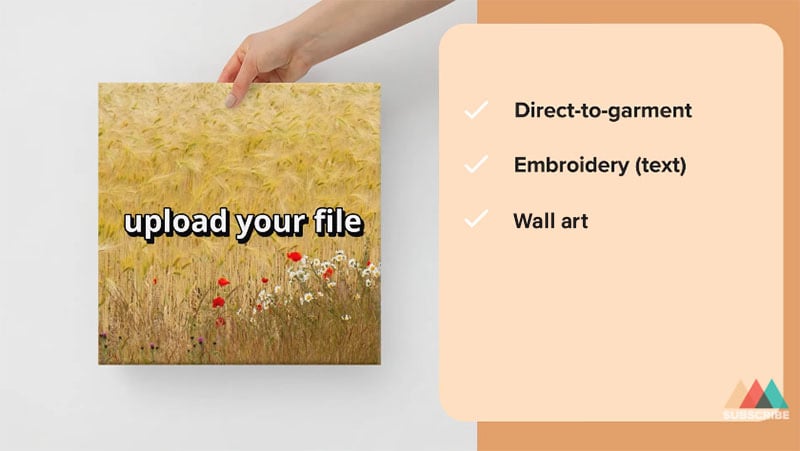
Branding options and packaging
Printful offers you more ways to add your own brand to your products and packaging than most competing POD companies.
When it comes to adding your brand or logo to your customized products themselves, there are quite a few options available.
You can add your brand to:
- inside labels
- outside labels
- sleeves
- the side and back for hats.
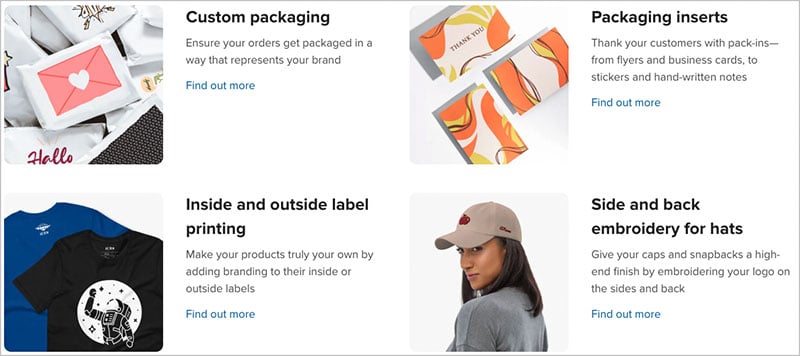
Printful also lets add your branding to your products’ order tracking page. You can add your company logo to this page, along with your contact information, links to your website and social media accounts.
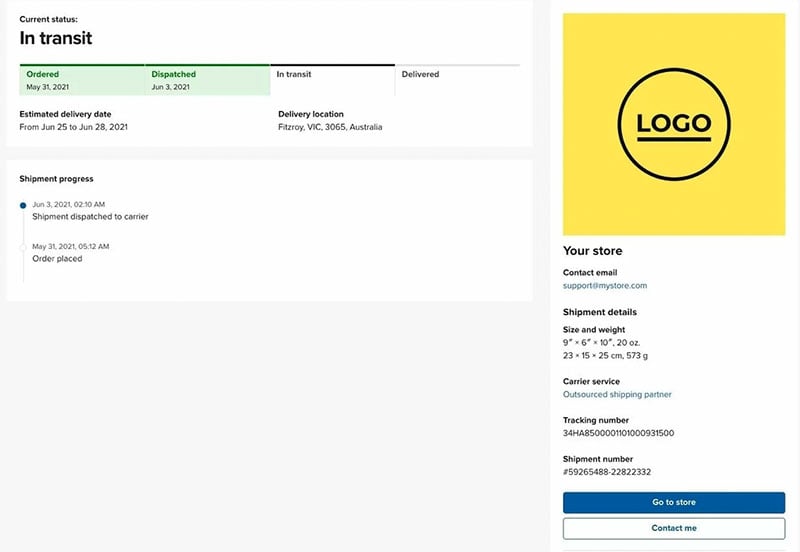
As for your customers’ packages, you can customize the packing slip and also choose to add a range of ‘packaging inserts’ to your packed products.
These include:
- flyers and coupons
- business cards
- branded stickers
- postcards
- thank you cards.
But can you apply your branding to the actual packages (bags, boxes, mailers, etc.) your products are shipped in?
Well, the first thing to say is all Printful’s packaging is ‘white label’, so there is no Printful branding on it.
Adding your own branding to outer packaging is technically possible; however, you’ll need to get it printed with a third-party packaging supplier and then send it to Printful to use with your orders. Doing so will involve additional costs from Printful for storage ($0.70 per cubic foot) and picking fees ($0.50 per pack-in).
(For the record, Printful recommends ‘Sticker Mule,’ ‘Arka’ and ‘PackHelp’ for creating customized branded mailers.)
All branding options can be managed in the ‘branding presets’ section of your Printful dashboard, where you can easily apply store-wide branding settings or different branding combinations for each of your Printful products.
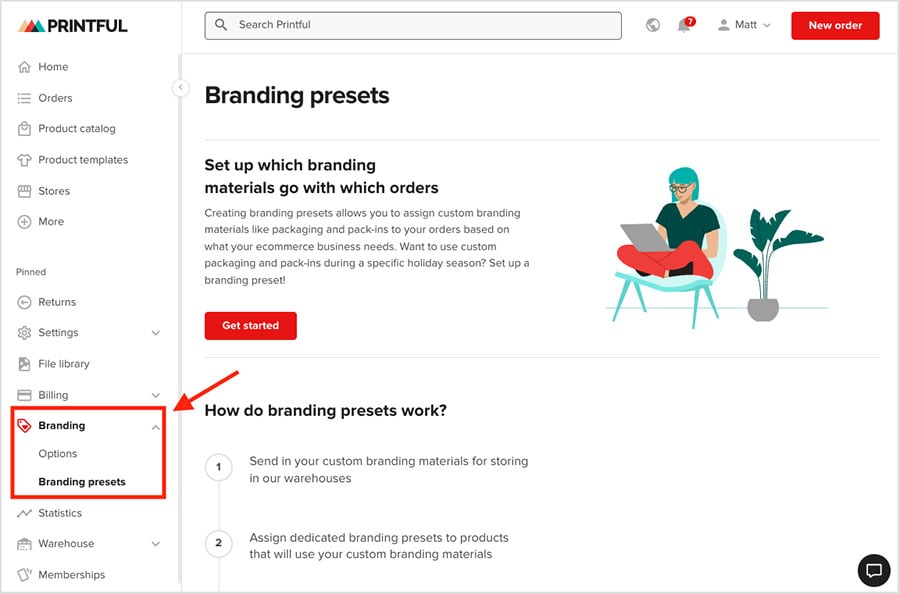
Shipping products with Printful
Printful partners with leading shipping services to get your products to your customers. Available carriers include:
- FedEx
- DHL
- UPS
- DPD
- Australia Post
- Royal Mail
- Latvijas PAST.
The platform also lets you display real-time live shipping rates from these shipping companies in your product listings, depending on the platform you’re using Printful in conjunction with.
(Live rates are currently only available with the Shopify, WooCommerce and Ecwid integrations).
As a merchant, you will always pay shipping fees to Printful — and it’s up to you to decide on whether to ask your customer to cover these (via a shipping fee) or offering free shipping (but higher product prices).
Now, Printful has around 22 different product shipping categories, each with different rates depending on your region. Here are some examples of the fees for some popular categories in the US:
| Shipping Product category | First item | Next item |
| Shirts | $4.69 | $2.20 |
| Embroidered hats, beanies, and visors | $3.99 | $2.00 |
| Beverage containers | $10.49 | $4.50 |
| Bags | $3.99 | $2.00 |
| Tech accessories | $3.99 | $0.75 |
| Posters and posters with hangers | $4.99 | $0.40 |
And to get a sense of the shipping cost and delivery times of some popular individual items (again, to customers based in the US), see the table below:
| Product | Shipping time | First item |
| Unisex Staple T-Shirt | 6 – 9 business days | $4.69 |
| Classic Snapback | 5 – 8 business days | $3.99 |
| Stainless Steel Water Bottle | 7 – 10 business days | $10.49 |
| Eco Tote Bag | 6 – 9 business days | $3.99 |
| Clear Case for iPhone | 8 – 11 business days | $4.49 |
| Enhanced Matte Paper Poster | 5 – 8 business days | $4.99 |
In terms of how Printful’s shipping costs compare to those of its rivals, they are in general a bit more expensive. On the plus side, Printful is the only company involved with shipping your goods — meaning that you are not faced with a myriad of shipping rates from a huge number of shipping suppliers (as is the case for example with competing POD supplier Printify).
You can learn more about Printify shipping services here.
Shareable templates feature
A very nifty Printful feature worth highlighting is its ‘Merchshare’ function — this lets you share a product template link with other people so that they can order (and pay for) a product you have customized for a special event.
The idea behind this is to minimize the administrative burden on event organizers in terms of collecting product sizes and shipping addresses from a large group of event attendees.
Instead of having to contact each person and create a spreadsheet of all the details, an event organizer can simply design the product in Printful, send a link to the attendees, who then pick their own size, color, quantity and pay for the item in Printful. The company will ship the items to each individual’s home address in advance of the event.
While this feature is not that relevant to ecommerce merchants, if you’re someone who has to arrange event clothing for a large group of people, you’ll definitely appreciate it.
Integrations with ecommerce platforms and marketplaces
Printful offers a wide number of integrations with ecommerce platforms and marketplaces, including Shopify, WooCommerce, Squarespace, Wix, Amazon, eBay, Walmart and Etsy.
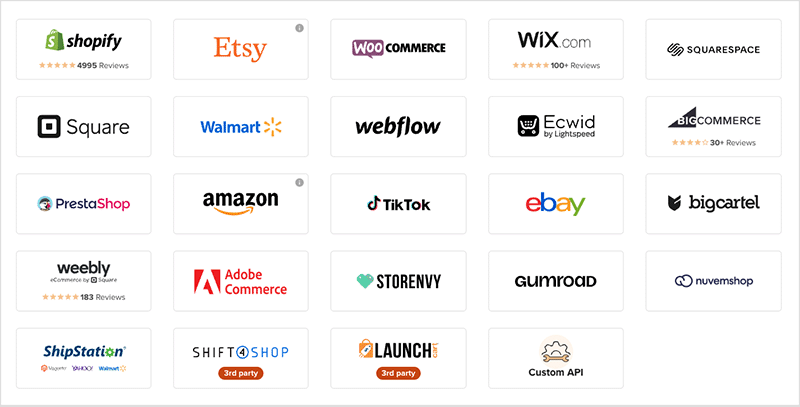
There are 23 integrations in all, which is considerably more than the number available for competing POD companies like Printify (10 integrations), Art Of Where (6 integrations), Spring (5 integrations) and SPOD (5 built-in integrations).
You can browse all of Printful’s integrations here.
The full set of platforms that Printful has integrations for is as follows:
- Shopify
- Etsy
- WooCommerce
- Wix
- Squrespace
- Webflow
- Ecwid
- BigCommerce
- Prestashop
- Square
- Amazon
- Walmart
- TikTok Shop
- eBay
- Big Cartel
- Weebly
- Adobe Commerce
- Storenvy
- Gumroad
- Nuvemshop / Tiendanube
- ShipStation
- Shift4Shop (3rd party integration)
- Launch Cart (3rd party integration).
Once you have connected your chosen ecommerce platform and / or marketplaces to your Printful account, you can easily ‘push’ your products to your storefronts in just a few clicks via the Printful dashboard.
Users should note that some of these integrations are lacking a few important features, however. For example, the Amazon, eBay and Square integrations don’t automatically display “out of stock” notices if a product becomes temporarily unavailable in Printful, which means you may have to update this information manually yourself.
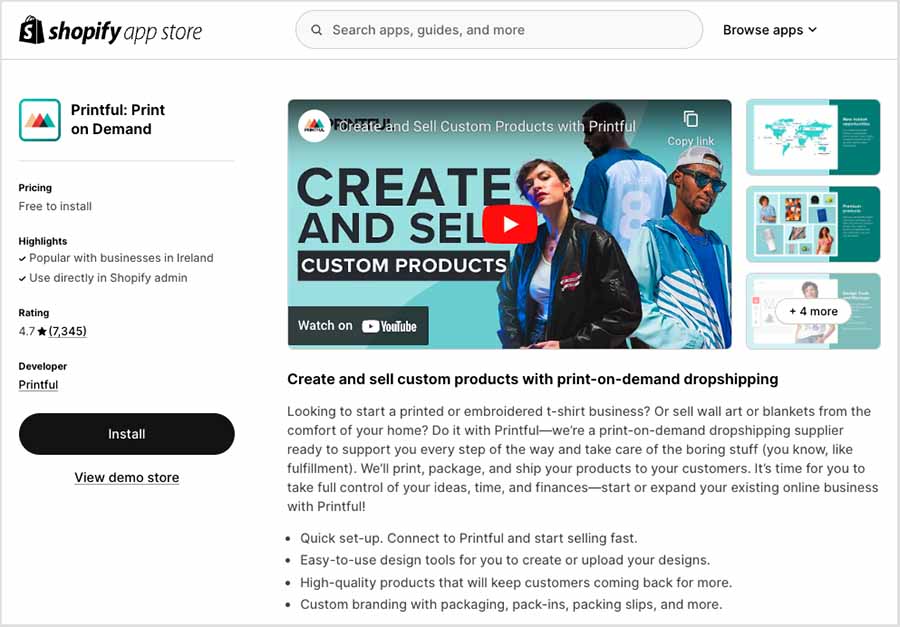
User reviews of the Printful integrations are generally good. For example, Printful averages 4.7 stars out of 5 from 7,340+ reviewers in the Shopify app store (pictured above), with more than 6.1k users giving the app a five star rating.
You can learn more about how the Shopify / Printful integration works in the video below or in our guide to connecting the two platforms; or you can try Shopify out for free here.
(Our guide to connecting Wix and Printful may also be of interest here).
Interface and ease of use
Printful is on the whole very easy to use — key print-on-demand tasks like customizing products, setting prices and pushing new products to integrated storefronts are all doable with a minimum of fuss, thanks to an intuitively-constructed interface.
The main Printful account dashboard features a menu on the left that allows you to access its key tools and settings, which you can then configure or edit on the right.
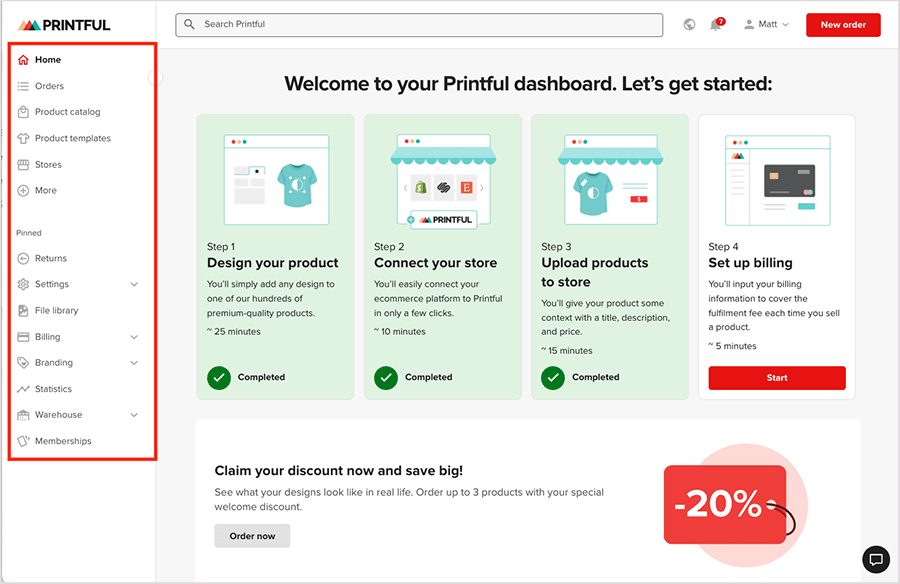
It’s also very straightforward to keep track of design files that you have uploaded to Printful. Its main dashboard includes a ‘file library’ that lets you organize files into folders; this is particularly useful when you start creating a lot of products and find that you have hundreds of design files in your account.

You can upload artwork files to the library directly from your computer, with options available that let you connect your Google Drive and Dropbox accounts for content-importing purposes.
Overall, I would say that the Printful interface is ‘best-in-class’ among the many POD companies vying for your ecommerce print-on-demand business.
Warehousing and fulfillment services
In addition to its printing business, Printful also runs a warehousing and fulfillment company that you can use to store or fulfill other products.
This works in a similar way to other warehouse fulfillment services like Fulfillment By Amazon or the Shopify Fulfillment Network, which let you send your products to the company for storage, packaging and shipping.
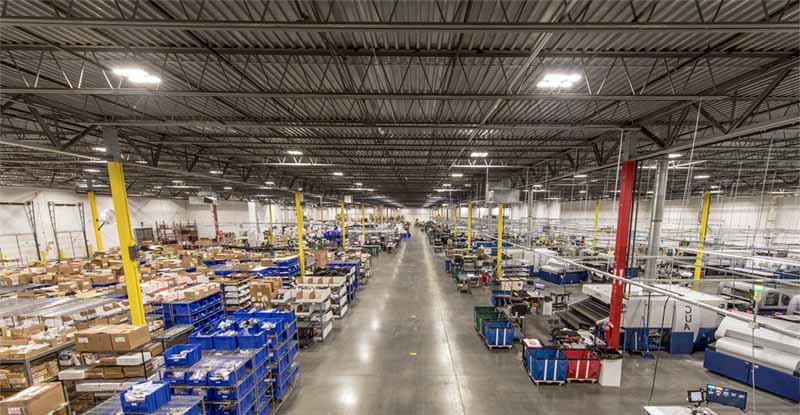
Printful has a network of 6 fulfillment warehouses across North America and Europe where your items can be stored, and the company offers same-day fulfillment and shipping for orders received by 12pm each day.
Storage costs for this service range are $0.70 per cubic foot, with a minimum monthly charge of $150 applying in the US (additional fees are charged for order picking and adding branded pack-ins to your packages).
Printful is the only POD supplier to offer this warehousing and fulfillment option for other goods, so a thumbs up to Printful for this one.
You can learn more about Printful’s warehousing and fulfillment services here.
Mobile apps
If you’d like to manage your Printful account via a mobile device, there are iOS and Android Printful apps available that help you do this.
These let you:
- browse Printful’s full product catalog
- confirm customer orders on your store
- access Printful customer support
- track your orders
- access analytics on your Printful account.
Of the two versions of the Printful app, the iOS version is a bigger hit with users, however.
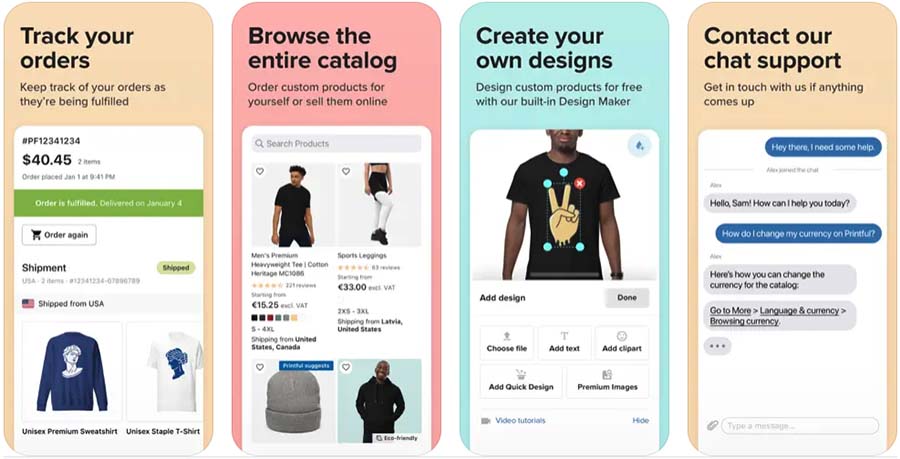
The iOS version of the Printful app scores 4.7 out of stars on the iOS App Store, while the Android version receives a 4.4 rating in the Google Play Store.
Printful pricing
There are no monthly fees to use Printful. This marks it out from key competitors, not least Printify, which charges $29 per month for its premium service.
You can set up a Printful account, create custom products, integrate your account with an ecommerce platform and list products for sale without paying Printful a penny to do so.
So what do you pay Printful for?
Well, Printful’s pricing model is very simple.
The company charges you when a customer buys one of your Printful products though your integrated ecommerce platform and / or marketplace. You are charged for…
- The product
The base cost of the product varies depending on the product type, size, and color.
- Printing
The cost of printing your design onto the product is determined by the printing technique you choose. For example, a standard ‘direct to garment’ digital print on a medium premium hoodie might be $25.45, while a high-quality embroidery print on the same hoodie might cost $27.45.
- Shipping
Shipping fees vary depending on the shipping method, destination, and weight of your package. Printful offers a variety of shipping options, including standard, expedited, and international. For the premium hoodie in the example above, shipping to the US starts at $8.49.
Now, it’s important to remember that a monthly fee for your chosen ecommerce platform or online marketplace will usually also apply; and, depending on the sales channel involved, you may also face a transaction fee.
Related resources: you can learn more about Shopify fees in our Shopify Pricing guide; and we cover Amazon and Etsy fees in our Shopify vs Amazon and Shopify vs Etsy comparisons.
Here are the prices for some of Printful’s most popular best-selling items:
| Price including default printing method | Shipping to US (starting price) | |
| Men’s Garment-Dyed Heavyweight T-Shirt | $14.95 | $4.69 |
| Enhanced Matte Paper Poster (11″ x 14″) | $9.75 | $4.99 |
| Unisex Premium Hoodie | $25.45 | $8.49 |
| Classic Dad Hat (Embroidery) | $14.25 | $3.99 |
| Clear case for iPhone 14 | $10.95 | $4.49 |
However, if you are buying products from Printful to assess them for print quality and item manufacture before listing them on your store — a practice I would strongly recommend regardless of your chosen POD supplier — Printful provides a 20% discount on all sample orders (limited to three products in one bundled sample order per month).
Compared with some key print-on-demand competitors, Printful’s pricing is generally cheaper than Spring’s, around the same as Spreadshirt and Teelaunch’s, but slightly more expensive than Printify’s (with the caveat that Printify pricing can vary significantly for an individual item depending on your choice of third-party fulfillment partner).
The good news is that you can reduce your Printful costs considerably by joining a new Printful discount scheme: ‘Printful memberships‘.
This scheme consists of two membership tiers — ‘Printful Growth’ and ‘Printful Business’ — which offer members significant discounts on standard Printful pricing.
You can access Printful for free here.
The available discounts on these two Printful membership tiers are as follows:
Printful Growth membership
- up to 20% off direct-to-garment products
- up to 30% off other product categories
- 7% off product branding
Printful Business membership
- up to 22% off direct-to-garment products
- up to 33% off other product categories
- 9% off product branding
- 25% off sample orders
- free digitization fee for all embroidered products (a saving of $2.95 – $6.50 per product)
You’ll need to make $12K per year in sales to access the ‘Growth’ membership discounts, and $60K per year to become a ‘Business’ member.
However, a paid option to join the ‘Growth’ membership scheme is now available too. This allows all Printful merchants to access these discounts (regardless of their sales volume) by paying a $24.99 per month membership fee.
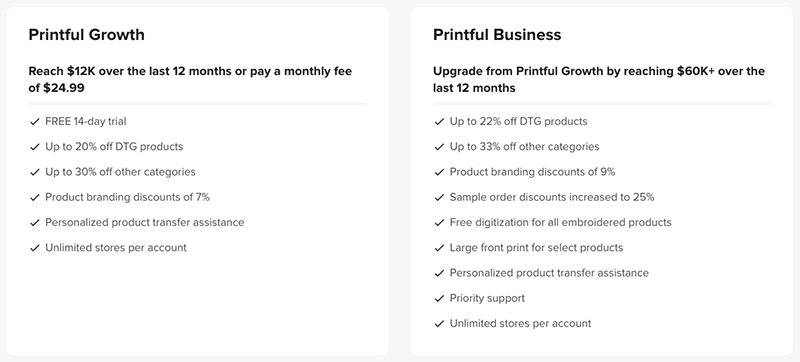
If you decide to use Printful to order customized print products for your own business (team t-shirts, brand posters, mugs with your company logo on them and so on), there are also discounts to be had if you order in bulk.
Printful direct bulk pricing starts with a minimum order of 25 products, with discounts ranging from 5% to 55% depending on the product.
Finally, Printful also charges for some of its customized branding options.
At present, these fees include:
- Packaging insert storage fees — $0.70 per cubic foot of storage
- Packaging insert picking fee — $0.50 per pack-in added to order
- Customized packaging storage fees — $0.70 per cubic foot of storage
- Customized packaging picking fee — $0.50 per mailer
- Adding a custom ‘inside label’ to a garment — $2.50 per garment
- Adding a custom ‘outside label’ to a garment — $2.50 per garment.
You can learn more about Printful pricing here.
Customer support
Printful customer support is comprehensive — help materials are available in 6 languages (English, Spanish, Italian, Japanese, German, and French), and you can contact the company 24/7 by email and live chat.
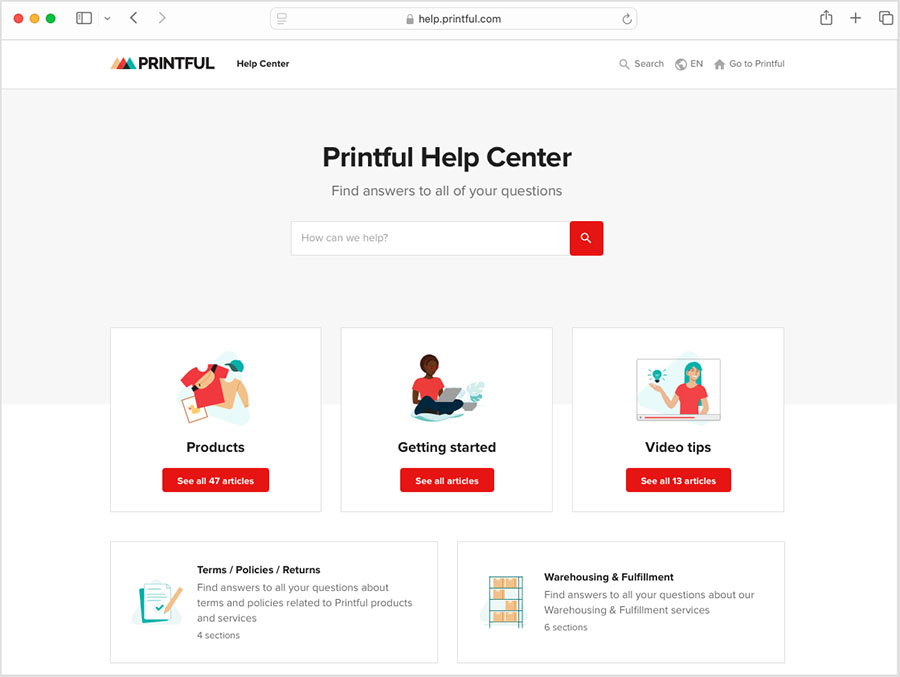
(Interestingly, the 24/7 live chat is operated by English-speaking agents but the customer service team is equipped with a translation tool, so chat support is technically available in many different languages. It would be good to see more ecommerce platforms that only currently offer support via English take a similar approach.)
Printful’s stated target for answering support queries is ‘within 2 hours’, although based on my experience of the live chat support, it is often quicker than that.
On the whole, Printful’s help center material is extremely clear, with a large range of text articles and video explainers on everything from connecting your account with Printful’s integration partners to the finer details of embroidery file formats and bulk ordering products.
Worth a mention too are the free print-on-demand and ecommerce resources on the ‘Printful Academy’ pages. These consist of various modular courses on digital marketing, ecommerce and design trends as well as bite-sized video content on a whole range of POD topics.
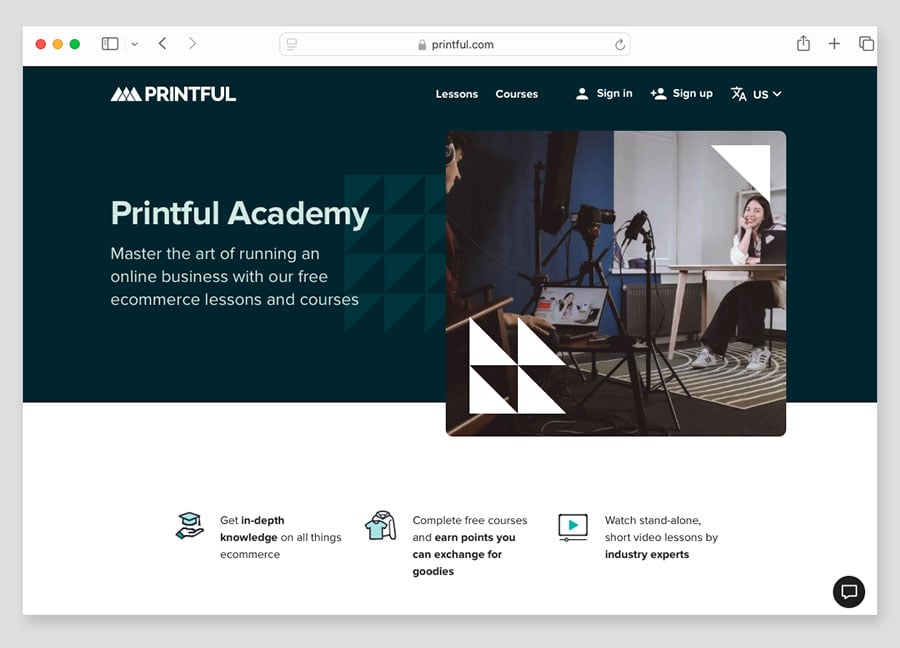
Upon completion of these courses, Printful account holders receive points that can be exchanged for various goodies and perks, for example, free Printful products, discount coupons and sample orders. (You’ll find these free perks in the ‘Printful Rewards’ section of your Printful account).
Finally, for making contact with and getting support from other Printful users, the ‘Printful Insiders’ Facebook group is worth checking out. This is an extremely active community with over 29k members sharing ideas on all aspects of Printful and running a print-on-demand business.
Printful review: conclusion
Overall, Printful is one of the very best services available for those wishing to sell print-on-demand products, and arguably the best for anyone who wants to offer these products on a large number of ecommerce platforms and marketplaces.
Because you can use the platform entirely free, it really does let prospective print-on-demand sellers launch a POD business with minimal risk.
Its products are reasonably priced — particularly when you consider the company’s strong reputation for consistent quality in terms of base product and printing processes.
And its product designer is easy to use, featuring more design assets and customizable mockups than most competing services.
So all in all, Printful is a really good option for anyone looking to start a print-on-demand business — but there are some downsides to be aware of too.
First, Printful’s product catalog is not as large as some competing services, so you may find that it simply doesn’t feature a particular item that you’d like to sell.
Second, Printful is not the cheapest print-on-demand service available. If you are looking for ‘bargain basement’ prices, you will be better-served by using a different POD company.
And third, because Printful prints and fulfils all products in its own in-house production facilities, some users may not like the fact that they can’t choose from a range of print suppliers or locations for the production of their goods.
I’ll leave you with a summary of the key pros and cons of Printful, and you’ll also find some information on some alternative tools below. If you have any queries or thoughts of your own on Printful, do leave them in the comments section!
You can try Printful out for free here.
Printful pros and cons
Reasons I think you should use Printful
- It’s extremely easy to use — you won’t face much of a learning curve when designing and selling products with Printful.
- There are no monthly fees or setup costs involved to use the platform.
- Its print products are of a very high quality. Printful’s products are generally regarded as being some of the highest-quality POD products on the market. The company works with leading suppliers to source high-quality materials, such as sustainable cotton, and offers a wide variety of printing techniques including direct-to-garment printing, embroidery, and cut and sew.
- Its custom branding options are very strong. The platform offers an excellent range of options for adding your own brand to your all aspects of your customer’s journey with your POD products. These include adding your brand to inside and outside clothing labels, packaging, packing slips, thank you cards and order tracking pages.
- Its discounts are generous. Printful’s membership scheme lets you access discounts up to 30% on orders if you sell more than $12,000 worth of products per month.
- It lets you offer product personalization. The product personalization feature lets your customers add their own text and images to your Printful products without leaving your online store.
- You can integrate Printful with a very wide range of ecommerce solutions. Printful integrates with many of the top ecommerce platforms and marketplaces, including Shopify, Squarespace, Wix, eBay, Etsy and Amazon. With 23 different integrations available, Printful gives you more than twice as many integration options as competing POD suppliers such as Printify and Spring.
- You can use Printful as the fulfillment service for all your products. Thanks to its warehousing service, Printful can take care of the storage, packing and shipment of your full product range — not just your print-on-demand items.
- Its sustainability and ethical practices are strong. Unlike some dropshipping POD companies, Printful has a very robust and transparent set of policies with regard to environmentally-friendly production methods and workers’ rights.
- It’s great for international selling. With Printful, you can sell to customers in over 170 countries. Its global network of production and fulfillment centers makes it possible to to produce and ship products from a Printful facility that is located close your customer, which reduces shipping times and costs.
Reasons I think you should avoid Printful
- Its product catalog is smaller than some other POD services. While Printful’s product library features a decent selection of 370+ items, other POD companies — for example Printify — offer a significantly larger product offering.
- Its products are relatively expensive. Pricing for quite a few Printful products are more expensive than comparable products from competing POD companies.
- You can’t choose your print location. Whereas some competing POD companies let you select a production facility in a particular location, you don’t get any say over this with Printful.
- There is no phone support.
- There are some hidden costs to consider. Although the large majority of Printful’s features are free, there are a few add-on services that require paying additional fees. These include a $1 fee for using premium photos in your designs, a $2.50 fee when you add your own branded apparel labels to products and stitch-count based pricing fees (from $3.95 to $19.95) for larger embroidery pieces.
Printful alternatives
There are quite a few alternatives to Printful available. Let’s take a quick look at some of the other providers currently operating in the print-on-demand market.
Printify
Of the many print-on-demand companies operating today, Printify probably represents the strongest alternative to Printful. Printify offers a considerably wider selection of products to customize, including more unique items like wireless earbuds, and you’ll find many more options in Printify within any one product category (15 types of canvas prints to just 3 types in Printful, for example). Additionally, Printify has a larger network of printing partners, which can sometimes result in a faster shipping speed and lower costs.
You can learn more about Printify in our comprehensive Printify review here, or see how it compares with Printful in our detailed Printful versus Printify comparison article here.
Spring (formerly Teespring)
Spring is a print-on-demand company aimed firmly at social media content creators. It provides direct integrations for Instagram, Twitch, Linktree, OnlyFans and Youtube — making it an interesting POD solution for creators on these platforms with a captive audience of potential buyers on their channel. You can learn more about how Spring compares to Spring in our detailed Printful vs Teespring (now Spring) comparison here.
Canva
Another option is to create and print your products using the design app Canva. This lets you create and print 60+ different types of products.
Now, this popular design tool differs from the other services discussed in this section because it’s a general-purpose design tool rather than a dedicated POD solution.
However, its extremely user-friendly design interface is far more powerful than those of most POD platforms, giving you access to a wider range of editing tools (brushes, photo-editors, background removers and many more) along with a massive range of stock images and graphics that you can add to your designs.
You can learn more about Canva in our full Canva Review and Canva Pro vs Free articles, or for a quick introduction to the platform, watch our ‘What is Canva?’ video guide below.
SPOD
If you’re looking for a POD supplier that offers very fast shipping, then the SPOD print-on-demand app is worth a look. This platform aims to ship orders within 48 hours, with the company claiming that around 50% of all orders are printed and shipped within just 24 hours. SPOD can also potentially be connected to hundreds of ecommerce marketplaces through an integration with the ‘Order Desk’ software automation service.
For a full overview of how this product stacks up against Printful, do check out our SPOD vs Printful comparison.
Printful review FAQ
Is Printful free for sellers?
It is completely free to open a Printful account, customize its products with your designs, integrate your Printful account with an ecommerce platform and market your products. However, for every Printful product you sell, the company charges you for the item’s production, printing, fulfillment and shipping. Other fees can apply for adding branded inserts to your packages or adding brand labels to your products.
How much does Printful setup cost?
There are no direct setup fees for using Printful — you can sign up for an account and use the platform to start creating and selling products for free. However, if you want to list your Printful products on an ecommerce platform or marketplace, you will have to pay a monthly fee and / or listing fee to your chosen service. For example, Shopify monthly fees start at $5 per month for its entry level plan; Etsy charges sellers $0.20 per product listing; and Amazon charges $0.99 per item sold if you sell fewer than 40 units a month.
Does Printful own my designs?
No — Printful does not own your designs. You retain all rights to your designs and can continue to use them however you wish outside of Printful’s services.
Is a print-on-demand business profitable?
Yes, a print-on-demand (POD) business can be profitable. They offer low startup costs, no inventory requirements and no minimum order amounts — and therefore minimal risk. Accordingly, with the right strategy in place, they have the potential to generate a really good return on investment.
However, you should note that in order to make a POD business work, you’ll need to invest time and money in things like online advertising, content marketing and SEO — all of which can be expensive to get right and need people with the right skills involved.
Does Printful check for copyright?
Yes, it does. When you upload a design file to Printful’s product designer, the platform uses automated technology to check for potential copyright and trademark infringement. If any issues are detected, the design will be rejected, and the customer will be notified (and possibly have their account suspended). Additionally, Printful has a team of legal and compliance specialists who review potentially infringing designs and take appropriate action if necessary. So it’s important that you have the rights and necessary permissions to use any logos, designs, photos and imagery that you upload to the platform.
Printful at a glance
| Year founded | 2013, Latvia |
| Products | 371 products |
| Total number of processed orders | 98 million |
| Integrations | 23 |
| Pricing | T-shirts start at $9.25 |
| Sample order discount | 20% |
| Product personalization | Available for Shopify, Etsy and WooCommerce integrations |
| Branding options | Inside and outside labels; on sleeves; and on the side and back of hats |
| Shopify app store rating | 4.7 stars |
| iOS app rating | 4.7 stars |
| Android app rating | 4.4 stars |
| Customer support | 24/7 email and live chat |
| Free trial | Yes — details here. |
Related resources
- What is Printful?
- Printful review (YouTube)
- Printful free trial guide (YouTube)
- What is Print on Demand?
- Printful pricing guide
- Printful vs SPOD
- Shopify review
- How to connect Printful to Shopify
- How to connect Printful to Squarespace
- How to connect Printful and Wix
- How to connect Printful to Etsy
- Dropshipping with Shopify
- Dropshipping resource hub
Comments (1)
Printful will print your graphic off-center and point to their DTG (direct to garment) process terms as being within their expected parameters.
I contacted Printful, and they essentially replied that they have every right to print your logo off center. No refunds.
Here’s their reply verbatim: “After looking at the photos, I can say the design placement is within our discrepancies. For the fulfillment, the human process is involved, which won’t guarantee a 100% placement for every single print. With that being said, the placement discrepancy is from 0.5”-1”, so from the fulfillment side, the outcome is expected.”
My band logo looks like it’s more than 1” off from center. It’s not even straight. But they’ll leave it to you to explain that to your customers and deal with any refunds they may want along with added return shipping costs.
So keep that in mind if you decide to go with Printful for your logo.